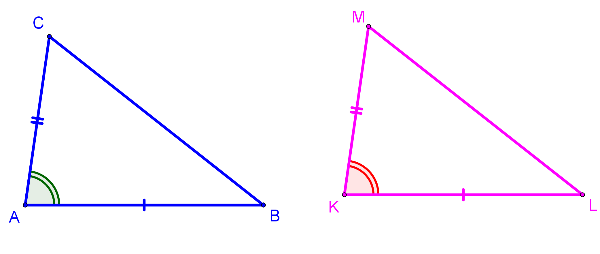Side-Angle-Side
SAS Illustrated

SAS Explained
If two sides and the included angle of one triangle are congruent to the
corresponding parts of another triangle, the triangles are congruent.
The "included angle" in SAS is the angle formed by the two sides of the triangle being used.
Below is an example how to construct this. If you change anything in the
construction, just click on the arrows on the top right to restore the
construction.
Example: Constructing SAS
Steps in constructing SAS
Now you try to draw a triangle congruent to the previous one You need to draw a triangle with side AB=5cm, included angle CAB=35 degrees and side AC=8. Try to do this in the "Applet" below
- Use
 to draw segment AB and if you are requested to give the length type in 5
to draw segment AB and if you are requested to give the length type in 5 - Use
 to draw an angle at point A. (Hint: Always click last on the point where you want the angle.) If requested for the angle size type in 35 degrees. Lastly you need to select clockwise or anti-clockwise. The direction of movement is from the line in a clockwise or anti-clockwise direction.
to draw an angle at point A. (Hint: Always click last on the point where you want the angle.) If requested for the angle size type in 35 degrees. Lastly you need to select clockwise or anti-clockwise. The direction of movement is from the line in a clockwise or anti-clockwise direction. - Use
 to draw a ray from point A through point B' that were created by the angle tool.
to draw a ray from point A through point B' that were created by the angle tool. - Use
 to draw a circle at point A and if requested to enter a radius type in 8
to draw a circle at point A and if requested to enter a radius type in 8 - Use
 to place point C at the intersection of the ray and the circle
to place point C at the intersection of the ray and the circle - Use
 to draw triangle ABC
to draw triangle ABC